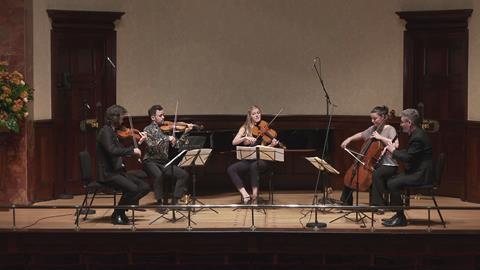Tim Homfray reviews what he heard on 23 November 2020 from London’s Wigmore Hall

Travel problems, presumably virus-related, meant only two members of the Elias Quartet were in this lunchtime concert, complemented by players from the Doric Quartet past and present. They opened with Beethoven’s C minor Trio op.9 no.3, in which they deftly combined occasional heft – muscular chords resounded mightily in the empty hall – with a lightness of touch which left Beethoven clear to speak with fluency and charm. There was more weight in parts of the Adagio, with cellist Marie Bitlloch to the fore and fleet demisemiquavers from the first violinist (deputy) Jonathan Stone. After the Scherzo, with its lilting Trio, the Finale was an energetic mix of dance and drama.
Arthur Bliss’s 1931 Clarinet Quintet should certainly be better known. In the opening Moderato, flowing melodic counterpoint, nicely elucidated, was punctuated by more sombre moments. The Allegro molto covers a lot of ground, full of rhythmic energy, with broad melodies, and a lively pizzicato passage, played with verve and textural clarity. Gentle melancholy suffused the Adagietto espressivo, moving into bleak elegy, and the final Allegro energetico was mostly full of gaiety, although here again some shadows fell. The quintet explores a complex emotional landscape, which the players traversed with expressive depth and eloquence.
TIM HOMFRAY






















































No comments yet